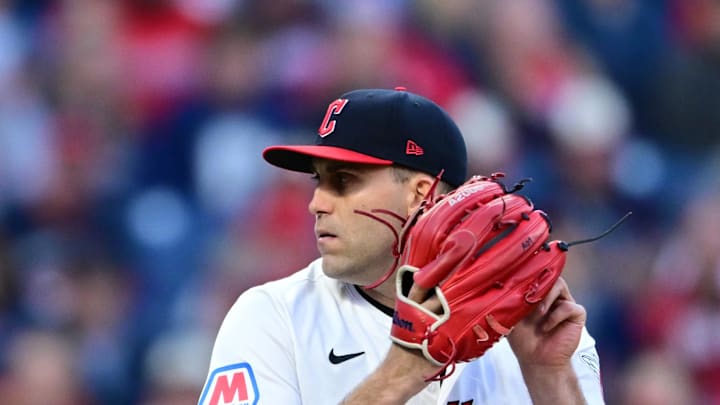In the very early hours of Monday morning, the Cubs landed their first big free agent fish of the offseason, handing Matthew Boyd a two-year, $29 million deal.
Boyd gets $29M for 2 years. $14.5M a year Plus $1M pbs (500K each year) #Cubs https://t.co/qy3QNP82pR
— Jon Heyman (@JonHeyman) December 2, 2024
The move feels similar to the John Lackey deal the Cubs executed almost a decade ago. Both contracts were of the same length at a similar value, for veteran pitchers coming off sub-3.00 ERA seasons (Lackey had a 2.77 ERA in 2015 with the St. Louis Cardinals; Boyd had a 2.72 ERA in 2024 with the Cleveland Guardians).
There are two main differences in the circumstances surrounding both signings: 1) Lackey was far more reliable than Boyd is now, and 2) the Cubs’ rotation was already well-defined when Lackey climbed aboard.
Boyd's injury troubles make him a perplexing addition to Cubs' pitching staff
Tackling that first point: Lackey, who was 37 years old at the time of his deal with the Cubs, pitched a whopping 359.0 innings over his two years in Chicago. Prior to signing with the team, he pitched 218.0 innings in 2015, 198.0 innings in 2014, and 189 1/3 innings in 2013. He was, by all accounts, a workhorse starter.
Boyd, on the other hand, is anything but. Between 2017-19, Boyd pitched 490 2/3 innings for the Detroit Tigers (posting an unsightly 4.70 ERA and matching 4.41 FIP). Since then, he’s thrown just 263.0 innings, with a similarly disappointing 4.65 ERA and 4.38 FIP. Over the last five seasons, he hasn’t exceeded 80 innings pitched once.
Of course, injuries have had a lot to do with his availability troubles. He missed nearly a season-and-a-half with a torn flexor tendon issue that required surgery after taking a while to diagnose, then tore his UCL in the summer of 2023 and had Tommy John surgery.
Boyd returned to pitch nearly 40 innings at the end of the regular season with the AL Central champions this past season, striking out over a quarter of the hitters he faced. He was then even better in the postseason, allowing just one run across three starts and 11 2/3 innings.
Even though he appeared healthy at the conclusion of this year’s campaign, it’s hard to call Boyd anything but a flight risk, especially since he’ll turn 34 before pitchers and catchers report in February.
The Cubs’ rotation is littered with upside and problems
Back when Lackey inked his deal, the Cubs were coming off an NLCS appearance. Jake Arrieta had established himself as a true ace alongside Jon Lester with one of the greatest halves of baseball ever, while young prospect Kyle Hendricks and veteran Jason Hammel were locked in at the back-end of the rotation. The team had a clear and obvious need for a No. 3 starter, and Lackey’s track record aligned perfectly with what the team was looking for.
Of course, Hendricks broke out and finished third in Cy Young voting in 2016, giving the team a trio of aces to build around, but Lackey more than held up his end of the bargain. He provided the Cubs with a sterling 3.35 ERA (3.81 FIP) in 188 1/3 innings in his first season on the North Side.
On the other hand, the modern iteration of the Cubs don’t really have a need for a pitcher like Boyd. Imanaga and Justin Steele — both southpaws, like Boyd — are pencilled in as the team’s No. 1 and 2 starters, though they aren’t the surefire aces that Lester and Arrieta were a decade ago.
Jameson Taillon recovered from a down year in 2023 to have a strong season in 2024, though relying on him to start two games in a seven-game series in the playoffs doesn’t sound very comforting. Javier Assad has broken out since joining the rotation at the tail-end of the ‘23 campaign, but he’s a back-end starter too.
Beyond that, the Cubs have a lot of young starting pitching depth with upside, including Jordan Wicks (another lefty), Hayden Wesneski, Cade Horton, Ben Brown, and Brandon Birdsell. Boyd is a better bet than any of those pitchers to contribute in a meaningful way in 2025, but his price tag ($14.5 million per year) and injury history make this allocation of resources tenuous at best.
What the Cubs need in a painfully obvious way is an ace; someone to take the ball in Game 1 of any postseason series. Imanaga and Steele are great pitchers, but they’re better suited to do battle with Aaron Nola and Christopher Sanchez rather than Zach Wheeler, should the Cubs match up with the Phillies in the playoffs (as one example).
Blake Snell is already on the Dodgers, though Corbin Burnes and Max Fried are both still lingering on the free agent market. Roki Sasaki is lingering over the entire offseason like a storm cloud. Garrett Crochet might not be any more of a No. 1 starter than Steele or Imanaga, but having three pitchers of that caliber is better than having two.
Matthew Boyd is a solid signing, but an unspectacular one. Great teams win around the margins with moves like this, but you can only be a great team by having the best players in the sport.
If they’re serious about making a postseason push next year, it’s time for the Cubs to bring in a pitcher of that caliber.
